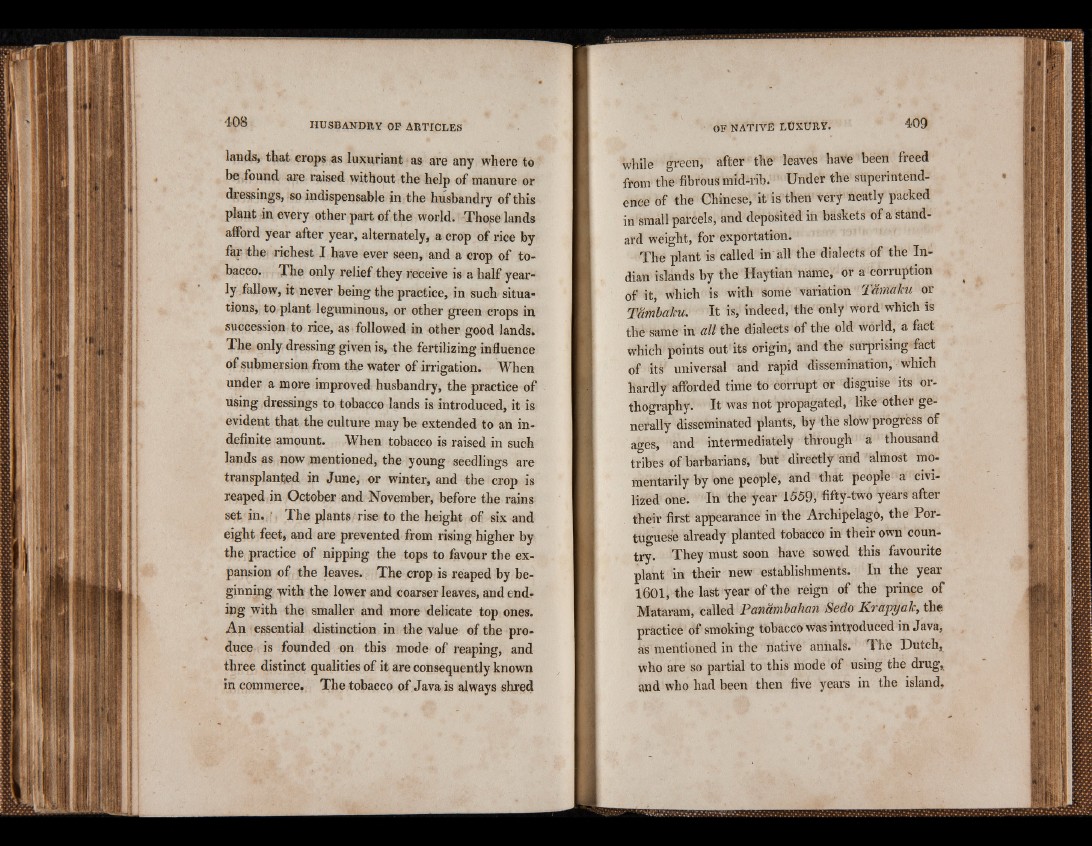
408 H U SBA N D R Y OP ARTICLES
lauds, that crops as luxuriant as are any where to
be found are raised without the help of manure or
dressings, so indispensable in the husbandry of this
plant in every other part of the world. Those lands
afford year after year, alternately, a crop of rice by
far the richest I have ever seen, and a crop of tobacco.
The only relief they receive is a half yearly
fallow, it never being the practice, in such situations,
to plant leguminous, or other green crops in
succession to rice, as followed in other good lands.
The only dressing given is, the fertilizing influence
of submersion from the water of irrigation. When
under a more improved husbandry, the practice of
using dressings to tobacco lands is introduced, it is
evident that the culture may be extended to an indefinite
amount. When tobacco is raised in such
lands as now mentioned, the young seedlings are
transplanted in June, or winter, and the crop is
reaped in October and November, before the rains
set in. ' The plants rise to the height of six and
eight feet, and are prevented from rising higher by
the practice of nipping the tops to favour the expansion
of the leaves. The crop is reaped by beginning
with the lower and coarser leaves, and ending
with the smaller and more delicate top ones.
An essential distinction in the value of the produce
is founded on this mode of reaping, and
three distinct qualities of it are consequently known
in commerce. The tobacco of Java is always shred
01? NATIVE LÛXURY. 409
while green, after the leaves have been freed
from the fibrous mid-rib. Under the superintendence
of the Chinese, it is then very neatly packed
in small parcels, and deposited in baskets of a standard
weight, for exportation.
The plant is called in all the dialects of the Indian
islands by the Haytian name, or a corruption
of it, which is with some variation Tamalcu or
Tambaliu. It is, indeed, the only word which is
the same in all the dialects of the old world, a fact
which points out its origin, and the surprising fact
of its universal and rapid dissemination, which
hardly afforded time to corrupt or disguise its orthography.
It was not propagated, like other generally
disseminated plants, by the slow progress of
ages, and intermediately through a thousand
tribes of barbarians, but directly and almost momentarily
by one people, and that people a civilized
one. In the year 1559, fifty-two years after
their first appearance in the Archipelago, the Portuguese
already planted tobacco in their own country.
They must soon have sowed this favourite
plant in their new establishments. In the year
1601, the last year of the reign of the prince of
Mataram, called JPanawbahan Scdo Kvapyalcy the
practice of smoking tobacco was introduced in Java,
as mentioned in the native annals. rl he Dutch,
who are so partial to this mode of using the drug,
and who had been then five years in the island,